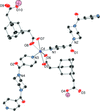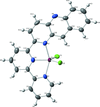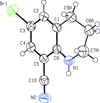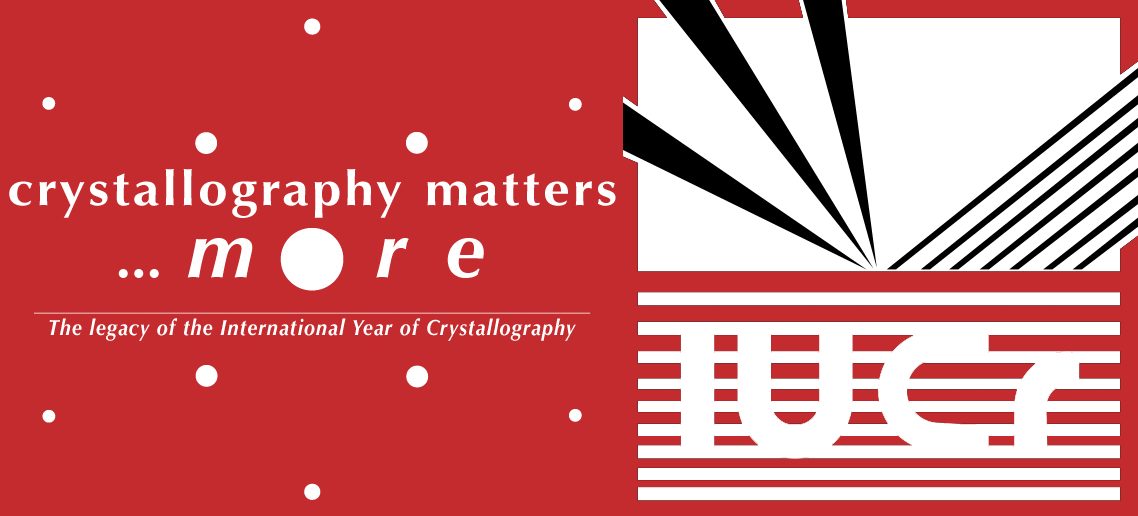issue contents
November 2016 issue

Cover illustration: 1,5-Dichloro-1,1,2,2,3,3,4,4,5,5-decaphenylpentasilane was obtained by a ring-opening reaction of decaphenylcyclopentasilane. The chain of silicon atoms adopts an all trans conformation. One of the Cl atoms is in an antiperiplanar conformation with respect to the Si chain [Cl-Si-Si-Si = -156.40 (5)°] while the other Cl substituent adopts a synclinal conformation. See: Neumeyer, Kotil, Auner & Bolte [IUCrData (2016). 1, x161812].
metal-organic compounds
Download citation


Download citation


Open  access
access
 access
accessIn the crystal, the cations are linked with the GaIII complex anions via weak C—H⋯F and C—H⋯π interactions.
CCDC reference: 1511879
Download citation


Download citation


Open  access
access
 access
accessIn the crystal structure of the coordination polymer, {(C4N2H14)[Mn2(C2O4)3]·6H2O}n, a two-dimensional honeycomb-like network is constructed from oxalate ligands and the MnII cations. Butane-1,4-diammonium ions are incorporated into the voids in the network as counter-cations.
CCDC reference: 1509829
Download citation


Download citation


Open  access
access
 access
accessIn contrast to the previous crystal structure determinations (room-temperature data) of the title compound, there is no disorder observed at 100 K.
CCDC reference: 1512691
Download citation


Download citation


Open  access
access
 access
accessThe crystal structure of the polymeric lead(II) thiourea complex [PbIICl2(SCN2H4)2]n has been re-refined with significantly higher precision and accuracy using single-crystal X-ray diffraction data with a CCD detector at 100 K.
CCDC reference: 1513661
Download citation


Download citation


Open  access
access
 access
accessThe structure of ferrocenecarboxylic anhydride is redetermined and the molecular and crystal structure of the molecule are detailed.
CCDC reference: 1515202
Download citation


Download citation


Open  access
access
 access
accessA cadmium 2-[3-(carboxymethyl)adamantan-1-yl]acetate (adaH) chain coordination polymer with N,N′-bis(pyridine-4-carboxamido)piperazine (bpcp) co-ligands, [Cd(adaH)2(bpcp)]n, was isolated and structurally characterized by single-crystal X-ray diffraction. O—H⋯O hydrogen-bonding interactions construct supramolecular layers, while non-classical C—H⋯O interactions form the full crystal structure of the title complex.
CCDC reference: 1515163
Download citation


Download citation


Open  access
access
 access
accessIn the title complex bearing a new NAD+/NADH-analogous ligand bbn, [Zn(C22H14N4)Cl2], the zinc(II) ion has a distorted trigonal–bipyramidal environment, coordinated by three N atoms from the bbn ligand and two Cl− ions.
CCDC reference: 1511041
Download citation


Download citation


Open  access
access
 access
accessA new CuII-based coordination polymer, obtained by a solvothermal method, shows a two-dimensional network which is connected by O—H⋯O hydrogen bonds to form a three-dimensional supramolecular structure.
CCDC reference: 1515776
Download citation


Download citation


Open  access
access
 access
accessThe title zinc(II) complex crystallizes with three independent complex molecules in the asymmetric unit. The ZnII atoms are coordinated by three N atoms of the 4′-phenyl-2,2′:6′,2′′-terpyridine ligand, and by the N atoms of two NCS− anions. In the crystal, the three molecules are linked by a number of offset π–π interactions, forming columns along the a-axis direction. The columns are linked via C—H⋯S interactions, forming a fence-like arrangement parallel to (001).
CCDC reference: 1514300
Download citation


Download citation


Open  access
access
 access
accessThe SnIV atom in the molecular title complex exhibits a trigonal–bipyramidal coordination environment with the C atoms of phenyl rings in the equatorial plane and the O atoms of the salicylate anion and the OPPh3 group in the axial piositions.
CCDC reference: 1517672
Download citation


Download citation


Open  access
access
 access
accessThe complex cation of the title compound adopts a distorted octahedral ClN4O coordination sphere.
CCDC reference: 1517485
Download citation


Download citation


Open  access
access
 access
accessThe title cuprato(III) complex crystallizes as a tetrahydrofuran monosolvate. The copper atom has a almost square-planar CuS4 coordination environment. The complex anion and the solvent molecule are linked via N—H⋯O and N—H⋯S hydrogen bonds involving the diisopropylammonium cation.
CCDC reference: 1519093
organic compounds
Download citation


Download citation


Open  access
access
 access
accessIn the crystal of the title spiro-pyrrolidine derivative, molecules are linked by N—H⋯N and C—H⋯N hydrogen bonds, forming sheets parallel to the ab plane.
CCDC reference: 1510867
Download citation


Download citation


Open  access
access
 access
accessIn the title compound, the orientation of the 2-oxopropylidene group substituting the 1,5-benzodiazepine ring is determined by an intramolecular N—H⋯O hydrogen bond.
CCDC reference: 1511185
Download citation


Download citation


Open  access
access
 access
accessThe title molecules are linked by C—H⋯O hydrogen bonds and C—H⋯π interactions, forming a three-dimensional network.
CCDC reference: 1511438
Download citation


Download citation


Open  access
access
 access
accessThe X-ray structure of an oxadiazole derivative, prepared from a substituted thiosemicarbazide, is reported.
CCDC reference: 1506092
Download citation


Download citation


Open  access
access
 access
access4-Phenyl-1-[(1R,4R)-1,7,7-trimethyl-2-oxobicyclo[2.2.1]heptan-3-ylidene]hydrazinecarbothioamide
The crystal structure of (R)-camphor-4-phenylthiosemicarbazone is reported. The molecular structure is stabilized by two intramolecular hydrogen-bonding interactions with graph-set motifs S(5) and S(6). The centrosymmetric arrangement of the molecules resembles a herringbone packing motif along [001].
CCDC reference: 1512001
Download citation


Download citation


Open  access
access
 access
accessThe molecule of the title compound exhibits point group symmetry 2, with the twofold rotation axis passing through the central S atom of the trisulfanediyl group.
CCDC reference: 1511354
Download citation


Download citation


Open  access
access
 access
accessThe title compound features non-planar molecules which are held together in the crystal by N—H⋯O, C—H⋯O and π–π stacking interactions.
CCDC reference: 1512930
Download citation


Download citation


Open  access
access
 access
accessThe planar molecular conformation is stabilized by intramolecular N—H⋯O and C—H⋯N hydrogen bonds. In the crystal, intermolecular N—H⋯O hydrogen bonds lead to  (8) ring motifs, and these aggregates are connected into sheets parallel to (101) via N—H⋯N hydrogen bonds.
(8) ring motifs, and these aggregates are connected into sheets parallel to (101) via N—H⋯N hydrogen bonds.
CCDC reference: 1513135
Download citation


Download citation


Open  access
access
 access
accessThe title benzoimidazole derivative is T-shaped, with the methoxyphenyl and the fluorobenzyl rings inclined to the benzoimidazole ring system by 40.91 (8) and 86.04 (8)°, respectively. In the crystal, molecules are linked via two pairs of C—H⋯O hydrogen bonds, forming inversion dimers with  (28) and
(28) and  (22) ring motifs. As a result of these hydrogen bonds, ribbons propagating along [010] are formed.
(22) ring motifs. As a result of these hydrogen bonds, ribbons propagating along [010] are formed.
CCDC reference: 1513685
Download citation


Download citation


Open  access
access
 access
accessThe title benzimidazole derivative, C24H22N2O3, is T-shaped with the methoxyphenyl and benzyl rings inclined to the imidazole ring system by 46.73 (10) and 88.88 (15)°, respectively. In the crystal, weak C—H⋯O hydrogen bonds link the molecules into [101] C(14) chains.
CCDC reference: 1514744
Download citation


Download citation


Open  access
access
 access
accessThe title molecule, which was prepared by degradation of amoxicillin with copper(II) sulfate in methanol, is approximately planar. In the crystal, layers formed by O—H⋯O and N—H⋯O hydrogen bonds interpenetrate each other.
CCDC reference: 1510980
Download citation


Download citation


Open  access
access
 access
accessThe title compound, [1–9-NαC]-linusorb B3 (cyclolinopeptide A), crystallized as an acetonitrile disolvate and is a new orthorhombic polymorph.
CCDC reference: 1511350
Download citation


Download citation


Open  access
access
 access
accessThe title compound crystallizes as a zwitterion, with the negatively charged benzenesulfonate group and the positively charged NH3+ group in mutually para positions. All the non-H atoms, except for one O atom of the sulfonate group, lie on a crystallographic mirror plane (Z′ = 1/2). In the crystal, molecules are linked by N—H⋯O hydrogen bonds, forming layers parallel to the bc plane.
CCDC reference: 1515425
Download citation


Download citation


Open  access
access
 access
accessIn the title compound, the diphenyl-1,3,4-oxadiazole unit is nearly planar but with the nitro group strongly twisted by 73.59 (16)° out of the plane of the benzene ring to which it is attached. In the crystal, C—H⋯O and C—H⋯N hydrogen bonds connect the molecules, forming ribbons propagating along direction [010].
CCDC reference: 1515447
Download citation


Download citation


Open  access
access
 access
accessThe crystal structure of 3,4-dimethoxyacetobenzophenone is reported. In the crystal, molecules are linked by C–H⋯O and π-π interactions.
CCDC reference: 1515734
Download citation


Download citation


Open  access
access
 access
accessBoth asymmetric molecules form carboxylic-acid inversion dimers in the crystal.
CCDC reference: 1515591
Download citation


Download citation


Open  access
access
 access
accessIn the title hydrate, the dihedral angle between the aromatic rings is 37.70 (10)°.
CCDC reference: 1513043
Download citation


Download citation


Open  access
access
 access
accessThe title carbazole derivative crystallized with two independent molecules (A and B) in the asymmetric unit. In the crystal, the A and B molecules are linked by a C—H⋯O hydrogen bond and stack along the b-axis direction.
CCDC reference: 1439578
Download citation


Download citation


Open  access
access
 access
accessThe dihedral angle between the triazolopyrimidine and fluorophenyl rings is 39.16 (12)°. In the crystal, molecules are connected through C—H⋯N hydrogen bonds.
CCDC reference: 1515262
Download citation


Download citation


Open  access
access
 access
accessThe title compound is a carbazole derivative with the 3-position substituted by a nitro group and the 9-position substituted by an n-butyl group.
CCDC reference: 1515348
Download citation


Download citation


Open  access
access
 access
accessOne of the phthalic acid carboxylic acid groups is deprotonated in the title salt. In the crystal, the anions are linked into an [001] chain by O—H⋯O hydrogen bonds. The cations are linked to these chains by N—H⋯O hydrogen bonds and weak C—H⋯O contacts, generating a three-dimensional network.
CCDC reference: 1515803
Download citation


Download citation


Open  access
access
 access
accessIn the title chalcone derivative, the dihedral angle between the aromatic rings is 19.13 (15)° and the double bond adopts an E conformation. In the crystal, molecules are connected by weak C—H⋯O hydrogen bonds, forming a chain propagating along the [001] direction.
CCDC reference: 1515842
Download citation


Download citation


Open  access
access
 access
accessIn the title compound, the dihedral angle between the pyrazole and phenyl rings is 53.86 (12)°. The piperazine ring adopts a chair conformation with the exocyclic N—C bonds in equatorial orientations. In the crystal, molecules are linked by very weak C—H⋯O hydrogen bonds, generating [010] C(8) chains.
CCDC reference: 1509001
Download citation


Download citation


Open  access
access
 access
accessThe title salt has a layered structure with hydrophilic and hydrophobic regions.
CCDC reference: 1517120
Download citation


Download citation


Open  access
access
 access
accessThe bond between the two chiral C atoms act as the bridge connecting the six-membered phenyl rings, the five-membered 1H-tetrazole ring and the acetamide unit. The molecules are linked through intermolecular C—H⋯O and N—H⋯N interactions.
CCDC reference: 1516411
Download citation


Download citation


Open  access
access
 access
access3H-1,2-Benzodithiole-3-thione is a 1,2-dithiole-3-thione derivative, a very promising bioactive compound family. The motivation behind the present study is understanding the crystal structure of this compound.
CCDC reference: 1515751
Download citation


Download citation


Open  access
access
 access
accessThe title compound belongs to the family of 1,2-dithiol-3-one derivatives, which contains bioactive compounds. Understanding the crystal structure of these compounds is the driving force behind this study.
CCDC reference: 1517056
Download citation


Download citation


Open  access
access
 access
accessThe dihydrobenzothiazine unit is twisted by 1.0 (2)°. The packing comprises chains running parallel to the c axis formed by weak C—H⋯O hydrogen bonds.
CCDC reference: 1517215
Download citation


Download citation


Open  access
access
 access
accessIn the title compound, the lattice solvent is strongly hydrogen bonded to the triazolethione substituent. The main molecules form columns parallel to the a axis with the solvent molecules located between the columns. Within the columns, C—H⋯S hydrogen bonds and C—H⋯π(ring) interactions are operative.
CCDC reference: 1517511
Download citation


Download citation


Open  access
access
 access
accessThe title compound was obtained by a ring-opening reaction of decaphenylcyclopentasilane. The chain of silicon atoms adopts an all trans conformation. One of the Cl atoms is in an antiperiplanar conformation with respect to the Si chain [Cl—Si—Si—Si = −156.40 (5)°] while the other Cl substituent adopts a synclinal conformation.
CCDC reference: 1516741
Download citation


Download citation


Open  access
access
 access
accessThe title 1,5-benzodiazepine forms chains in the crystal through N—H⋯O hydrogen bonds, reinforced by intermolecular O—H⋯π(ring) and C—H⋯π(ring) interactions.
CCDC reference: 1517939
Download citation


Download citation


Open  access
access
 access
accessThe title 1,2,4-triazole derivative crystallizes with a disordered dimethyl sulfoxide molecule. In the crystal, the components form centrosymmetric dimers that are linked together by classical and non-classical hydrogen bonds, as well as π–π stacking.
CCDC reference: 1518058
Download citation


Download citation


Open  access
access
 access
accessInversion dimers linked by pairs of N—H⋯N hydrogen bonds generate  (12) loops.
(12) loops.
CCDC reference: 1518057
Download citation


Download citation


Open  access
access
 access
accessIn the crystal of this bis-chalcone compound, the molecules are linked via weak C—H⋯O hydrogen bonds, forming supramolecular chains propagating along the [100] direction.
CCDC reference: 1518584
Download citation


Download citation


Open  access
access
 access
accessThe title molecule adopts a cup-shaped conformation in the crystal with the planes of the two benzene rings and the benzotriazole units close to being parallel.
CCDC reference: 1518502
Download citation


Download citation


Open  access
access
 access
accessIn the title compound, the seven-membered benzodiazepine ring adopts a twist-boat conformation and the two aromatic rings are inclined to one another by 81.06 (15)°. In the crystal, molecules are linked by N—H⋯O hydrogen bonds, forming chains propagating along the [10 ] direction.
] direction.
CCDC reference: 1518908
Download citation


Download citation


Open  access
access
 access
accessThe title hydrazide compound crystallizes with two independent molecules (A and B) in the asymmetric unit. The dihedral angle between the 4-methoxyphenyl ring and the toluene ring is 88.13 (10)° in molecule A and 61.47 (10)° in molecule B. In the crystal, molecules are linked via pairs of N—H⋯O hydrogen bonds, forming A–A and B–B inversion dimers with  (8) ring motifs.
(8) ring motifs.
CCDC reference: 1518861
Download citation


Download citation


Open  access
access
 access
accessThe title phenothiazine derivative crystallizes with two independent molecules having similar conformations in the asymmetric unit. Both phenothiazine units have a butterfly structure, with the dihedral angles between the planes of the benzene rings being 17.95 (13) and 12.65 (14)°.
CCDC reference: 1511272
Download citation


Download citation


Open  access
access
 access
accessThe asymmetric unit of the title compound contains the two independent molecules, which form a dimer via N—H⋯O hydrogen bonds.
CCDC reference: 1519100
Download citation


Download citation


Open  access
access
 access
accessThe structure of the title pyrido[2,3-b]pyrazine is reported. Its crystal structure features offset π–π stacking interactions.
CCDC reference: 1518915
Download citation


Download citation


Open  access
access
 access
accessThe structure of the monoclinic polymorph of the title compound is similar to that of the orthorhombic polymorph, and the aliphatic C atoms are also disordered. In the crystal, molecules are linked by a pair of O—H⋯O hydrogen bonds, forming inversion dimers with an  (8) ring motif.
(8) ring motif.
CCDC reference: 1519137
Download citation


Download citation


Open  access
access
 access
accessThe structure of 4-(benzo[d]thiazol-2-yl)-N,N-dimethylaniline is stabilized by π–π contacts.
CCDC reference: 1502512


 journal menu
journal menu

































































![[publCIF]](/logos/authorchecklist11.gif)





